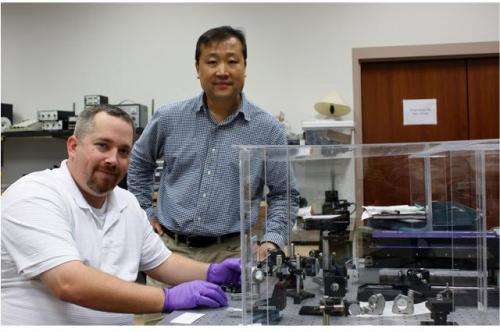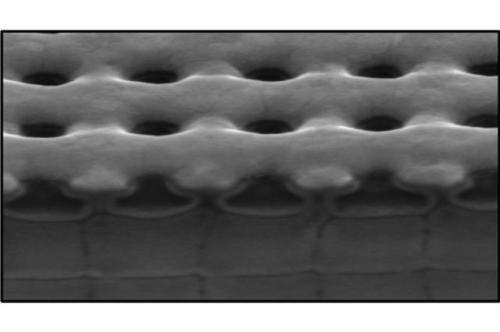Exploring extraordinary optical transmission in a plasmonic cavity

Researchers at New Mexico State University in the US have investigated extraordinary optical transmission in a plasmonic cavity. The device they have developed features a hybrid surface plasmon polariton/Fabry-Pérot cavity, which gives an improved Q-factor and demonstrates its suitability for use in biosensors and photonic circuits.
The main achievement by the team was that of extraordinary optical transmission (EOT). EOT is the surprising phenomenon where a sub-wavelength aperture can transmit considerably more light than would classically be expected. The phenomenon is caused by the presence of surface plasmon polaritons.
Plasmonic cavities have long been of interest to researchers in the field due to the fact that they are naturally nanoscale and easily miniaturised. However, high ohmic losses in metal at optical frequencies mean that they have suffered from low q-factors and the US team expect their design to address these issues.
Exciting lighting
Surface plasmon polaritons (SPPs) are a collective excitation or 'quasiparticle' involving interactions between charged particles (electrons in a plasma or metal) and electromagnetic fields (light). At a metal-dielectric interface – where the real part of the permittivity changes sign – the conduction electrons are excited collectively, which is described by plasmons. If light is incident on the metal, polaritons will form and the interaction of the plasmon and the polariton is described through SPPs.
In order to generate stable SPP excitations, the team manufactured a hybrid cavity that consisted of an array of nano-structured metal rods embedded in a dielectic cavity. A Fabry-Pérot structure was then introduced across the system – effectively two mirrors on either side of the cavity. The nanoscale array acts to create the surface plasmons and the photonic standing wave (or mode) created by the Fabry-Pérot cavity provides the light that leads to the formation of SPPs.

Periodic improvement
This effective SPP array is what allows for extraordinary optical transmission. Classically, for a sub-wavelength aperture, one would expect isotropic diffraction and hence low transmission. However, in 1998 it was shown that periodic structures can overcome this effect and enhance transmission of light. This makes the effect extremely important in the creation of photonic circuits.
It has been shown that SPPs are responsible for the effect, and the team's array may be introduced into devices to improve transmission. Of course, the transmission will be maximal at a resonant frequency, which in the current device is around 800 nm. However, changing the dimensions of the array and cavity can tune this resonance.
Integration and quality
The presence of EOT means that these nanoscale devices can be used in a wide variety of applications, for example, as mentioned above, integrated photonic circuits. As EOT structures are intrinsically nanoscale, they lend themselves to integration so could be used in photonic interconnects or waveguides.
Another intriguing possible application is in chemical and biological sensing. This is made possible by the relationship between the SPP dispersion and the change in permittivity between the metal and the dielectric. The presence of a foreign body, biological agent or element will affect the relative permittivity, changing the SPP dispersion and so shifting the frequency of the EOT resonance.
As the team's cavity demonstrated a 39% improvement in Q-factor, they believe that engineered nanostructured devices are on the verge of mainstream commercial application, and the possible fields do not just include those mentioned above. The insight into hybrid cavity devices they have provided can be applied to research into evermore diverse areas, from colloidal quantum dot based sources to spectral engineering and metamaterials.
More information: "Hybridised extraordinary optical transmission in plasmonic cavity." Electronics Letters, Volume 50, Issue 24, 20 November 2014, p. 1860 – 1862 DOI: 10.1049/el.2014.2818 , Print ISSN 0013-5194, Online ISSN 1350-911X
Journal information: Electronics Letters
Provided by Institution of Engineering and Technology
This story is published courtesy of Electronics Letters. For additional Electronics Letters news and features visit theiet.org/eletters.



















